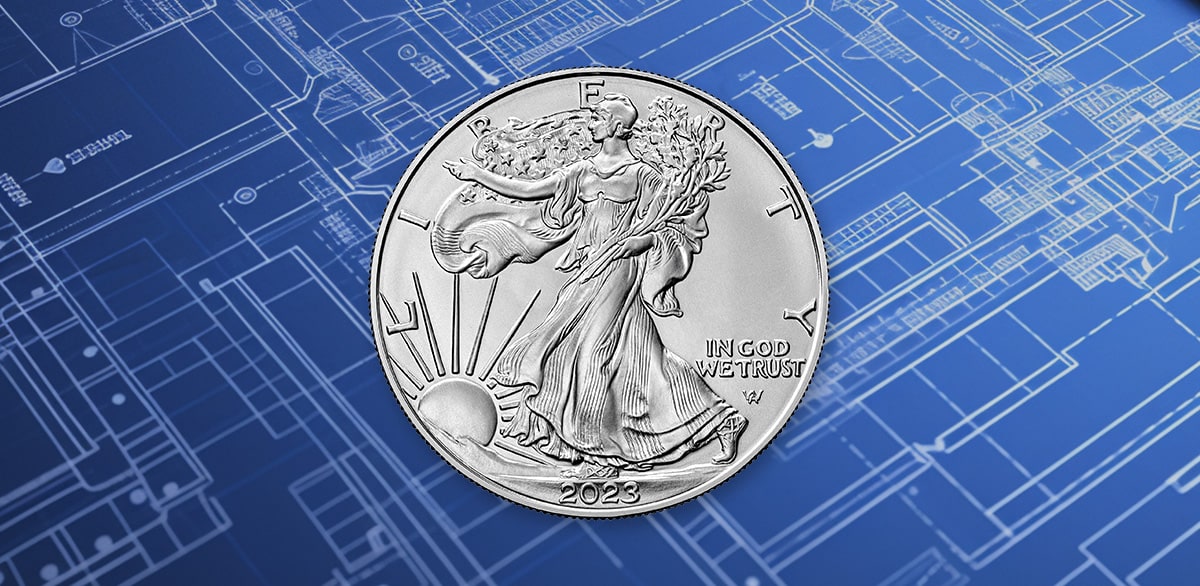
Gold and silver coins can be reliable investment vehicles with promising growth potential and solid returns for investors, especially for those looking to optimize portfolio diversification. Due to the rarity and value of certain coins, an entire lexicon of jargon has been developed to describe these investments in depth.
At first, hearing these industry-specific terms can sound like a foreign language. As you become more familiar with the terminology, you’ll gain a better understanding of different types of coins, why they’re valuable, and whether they’re a good investment for your goals.
Coins (General)
The sheer number of gold and silver coins can be daunting for new coin buyers. However, there are some overarching characteristics nearly all coins share, making it easier to describe them accurately. Here are some common terms that relate to most coinage:
Obverse
The obverse side of a coin refers to the front. It’s more colloquially known as “heads” because a majority of coin designs feature a portrait or bust on this side. You might also hear some people referring to the obverse as the “top” of a coin.
Reverse
As the name suggests, the reverse designates the back of a coin which would be called “tails” in daily parlance. Although many American coins feature a bald eagle on the reverse side, the colloquial terminology actually has nothing to do with the bird’s tail feathers. It’s simply referred to as “tails” because it’s the opposite of heads.
Date/Year
Most coins bear their mint year on the obverse side below whatever design is emblazoned on the front. Usually, this is simply described as the “date”.
Motto
Phrases such as IN GOD WE TRUST and E PLURIBUS UNUM are commonly seen on US coins. Of course, foreign coins will bear different mottos. These sayings can vary based on the design, mint year, and location of production.
Denomination
A coin’s face value is often marked on the obverse side. This represents how much the coin is worth in terms of legal tender. Keep in mind that investment-grade coins are often worth more than their denomination because of their rarity and history.
Mint Mark
Mint marks are identifiers that reflect where a coin was minted. For example, US coinage typically features a single-letter designating a specific Federal mint location. For example, the Philadelphia Mint is represented by a “P”.
Edge
The edge refers to the exterior surface of a coin that wraps around its circumference. This seemingly insignificant part of the coin is actually referred to as the “third side” by some experts which highlights its importance. Here are some common types of coin edges:
Plain
The default edge design for coins is a smooth surface without any lettering or design. You find these plain edges on standard pennies and nickels.
Reeded
Reeded edges feature vertical grooves which offer a better grip and a more aesthetic design than their plain counterparts. Quarters and dimes feature this type of edge.
Lettered
Any inscription along the outside perimeter of a coin is known as a lettered edge. These letters or symbols can feature a motto, mint mark, date, country of origin, and much more.
Decorated
Most elaborate designs are simply described as decorated edges. Some popular impressions include vines, flowers, and abstract designs.
Keep in mind that a coin can feature multiple edge designs at once, depending on the complexity of its design.
Rim
The rim of a coin is the raised border surrounding both the obverse and reverse sides. It’s closely related to the edge but refers specifically to the perimeter on either side of the coin. In addition to adding an aesthetic charm, the rim protects the coin’s designs from damage when stacked or set down.
Finish
A coin’s finish describes the appearance of the coin’s surface. There are three main classifications of finish: circulating, uncirculated, and proof. Circulating coins are minted using a standard process and enter into daily use within the economy. The difference between proof and uncirculated coins is a little less clear. Both undergo a special minting process and receive special packaging. However, proof coins are double-struck and hand-polished which results in a more refined and shiny appearance.
Graded Coins
Coin grading is a classification process through which coins are given a specific grade based on their condition. These grading systems take a variety of factors into account such as strike, luster, appearance, preservation, and mint location. The higher level of scrutiny graded coins receives lends itself to even more coin jargon.
Strike
A coin’s strike speaks to the actual imprinting of a blank coin which is officially known as a planchet.
Luster
Luster is the way a coin’s surface reflects light to produce a shine. The more flashy or shiny the coin, the higher the quality of luster. When accessing a coin’s grade, luster is an important consideration due to its impact on condition and aesthetic charm.
Bag Mark
Any minor dent or scratch on a coin is generally referred to as a bag mark. During the minting process, non-proof coins are loaded into giant bags where they inevitably get damaged from contact with other coins. Imperfections don’t have to derive from this specific process to be called bag marks though.
Field
The field is any area on a coin’s obverse or reverse that hasn’t been imprinted. It’s the space between different designs on the strike such as the bust, denomination, or motto.
Grade
Grading a coin is the process of rating a coin’s overall condition. Each grade represents a different level of quality based on a variety of factors including aesthetics, preservation, strike, luster, and preservation. Here are the different coin grades based on the internationally accepted Sheldon Scale:
- MS (60 to 70): Mint state or uncirculated
- AU (50 to 59): About uncirculated
- XF (40 to 49): Extremely fine
- VF (20 to 39): Very fine
- F (11 to 19): Fine
- VG (8 to 10): Very good
- G (4 to 7): Good
- AG (3): About good
- FA (2): Fair
- PR (1): Poor
If you’re interested in learning more about how to invest in gold and silver coins, claim a FREE copy of our Precious Metals Investment Guide today.


